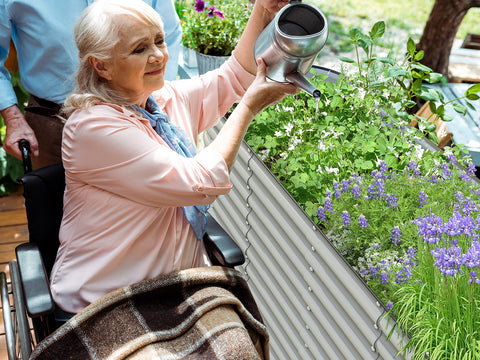Tips from Olle Garden Bed: 5 Smart Ways To Use Oatmeal In The Garden
Oatmeal is good for your health, but it is also good for your garden. Therefore, if you are looking for effective ways to control pests, alleviate poison cane burns and deal with sticky juice, oatmeal can help. Use these guidelines from Olle Garden Beds to find the best ways for your needs.
Advantages and disadvantages of oatmeal
According to the data of the Food Data Center, 1 ounce of dry oatmeal contains 10.5 grams of iron, 108 mg of potassium and 136 mg of phosphorus. In addition to improving the nutrient content of the soil, it also helps to eliminate pests, is very suitable for composting, and helps to eliminate poison rattan rash.
Although oats have good uses in the garden, too many may be bad because they attract birds and rodents. Unless you only want to attract birds, if you use it as natural mulch or fertilizer, they will eat oatmeal.
Another reason that too much oatmeal may cause damage is its water retention performance. Because it retains a large amount of water, it may be the main cause of mold and fungi. Therefore, if you scatter it too close to the plant stem, if it retains too much water, it may rot. For this reason, they must be separated from the stems of plants.
Five smart ways to use oatmeal in the garden
Now that you have mastered some basic information, the following is how to skillfully use oatmeal in the garden.
1.Water with oatmeal
Oat water is a popular way to fertilize plants. However, please make sure to use uncooked oats because they contain more nutrients and have no artificial ingredients such as sugar or seasoning.
To prepare oatmeal water, please mix a cup of uncooked oatmeal with five liters of water and let it stand for several days. After a period of time, the water will become turbid, and you may notice a slight odor associated with bad food.
Filter the oats, throw them into the compost box, and feed the plants with oatmeal water! You can use the water injected by oatmeal to irrigate the indoor and outdoor plants to improve the nutrient level of the soil.
2.Oatmeal as pest control
If you are struggling with slugs or snails, oatmeal is an environmentally friendly alternative to chemical pesticides. Snails and slugs like to eat. They like to chew oatmeal. They hardly knew that it was bad for them.
When a snail or slug chews dry oats, it will swell in the stomach after absorbing body fluids. The swelling makes them more slow and makes it easy for birds to pick them up.
Lay a thick layer of oatmeal around your plants, but make sure it is not too close to their stems. The distance between oatmeal and plant stem should be such that when you water the plant, oatmeal should be away from the stem, not towards the stem.
Keep in mind that oats can become sticky, especially if you spread them before watering plants or wet weather. Viscous oatmeal will not help you get rid of snails, so it is important to spread it after watering plants and update it every day to ensure that they remain dry.
3.Oatmeal in compost
The compost box may be very picky about what you can and can't compost! Although there are some things you should not put in the compost box, oats are not one of them. In addition to potassium, phosphorus and iron, oatmeal also adds copper, zinc and manganese to your compost pile.
Instead of throwing old oatmeal into the garbage can, add it to the compost pile to provide nutrition for your plant in the coming growing season.
4.Treatment of poison rattan rash
Oats can be a natural therapy for relieving the rash of poison ivy. To treat inflammation with oats, grind 1 to 2 cups of uncooked common oats in a blender or food processor until they form fine powder. Fill the bathtub with warm water and sprinkle with oatmeal.
Soak in the oatmeal bath for 15 to 20 minutes, and then pat the skin dry with a towel. The anti-inflammatory properties of oats can help reduce redness and itching caused by skin rash. Oats can also help moisturize and soothe the skin, relieve inflammation and discomfort.
However, it is important to note that such remedies may not be suitable for everyone, especially in serious cases. If your rash is serious or does not improve through home treatment, you must seek medical care from a health care professional.
5.Take care of sticky juice
Working in the garden can often become messy, especially if you don't wear gloves and handle sticky juices. It is not surprising that this juice is difficult to remove, so oats can help. How many oats you need depends on the size of the affected area.
Wipe oatmeal on your hands before washing with soap and water. The abrasiveness of oats will quickly release mucus or juice, and it is easy to remove when washing hands.
Your hands will also thank you for your moisturizing!
That's oats standing!
Oatmeal is very useful for your health, but it is also useful in the garden. In addition to preventing pests such as slugs and snails, oatmeal water is a good way to improve soil nutrient level to benefit your plants.
However, oatmeal is famous for its water retention, so please make sure not to put it too close to the plant stem, because it may rot. Oatmeal also attracts insects, birds and rodents, which are difficult to eliminate. Nevertheless, if you use oatmeal responsibly, your garden will benefit from its nutrition.


How often do I water my plants with oat water? Can you use oat water too much? Thank you. T